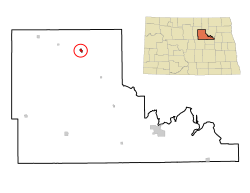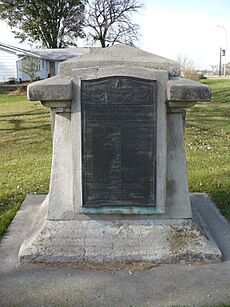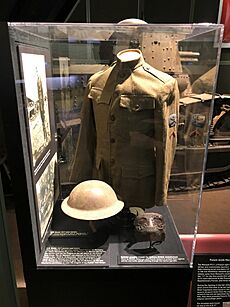Leeds, North Dakota facts for kids
Quick facts for kids
Leeds, North Dakota
|
|
|---|---|

Location of Leeds, North Dakota
|
|
| Country | United States |
| State | North Dakota |
| County | Benson |
| Founded | 1887 |
| Area | |
| • Total | 0.67 sq mi (1.73 km2) |
| • Land | 0.63 sq mi (1.64 km2) |
| • Water | 0.04 sq mi (0.09 km2) |
| Elevation | 1,516 ft (462 m) |
| Population
(2020)
|
|
| • Total | 442 |
| • Estimate
(2022)
|
426 |
| • Density | 698.26/sq mi (269.78/km2) |
| Time zone | UTC-6 (Central (CST)) |
| • Summer (DST) | UTC-5 (CDT) |
| ZIP code |
58346
|
| Area code(s) | 701 |
| FIPS code | 38-45580 |
| GNIS feature ID | 1036124 |
Leeds is a small city in Benson County, North Dakota, United States. In 2020, about 442 people lived there.
Leeds was started in 1887. It got its name from Leeds, England. It was one of many towns along the Great Northern Railway's path across the country. These towns were often named after places in England. Other towns like Berwick, Norwich, and Rugby also got their names this way.
Contents
Where is Leeds Located?
Leeds is located in North Dakota. The city covers a total area of about 0.67 square miles (1.73 square kilometers). All of this area is land. A lake called Lake Ibsen is located about 1.5 miles (2.4 km) southeast of the city center.
How Many People Live in Leeds?
| Historical population | |||
|---|---|---|---|
| Census | Pop. | %± | |
| 1900 | 349 | — | |
| 1910 | 682 | 95.4% | |
| 1920 | 704 | 3.2% | |
| 1930 | 725 | 3.0% | |
| 1940 | 782 | 7.9% | |
| 1950 | 778 | −0.5% | |
| 1960 | 797 | 2.4% | |
| 1970 | 626 | −21.5% | |
| 1980 | 678 | 8.3% | |
| 1990 | 542 | −20.1% | |
| 2000 | 464 | −14.4% | |
| 2010 | 427 | −8.0% | |
| 2020 | 442 | 3.5% | |
| 2022 (est.) | 426 | −0.2% | |
| U.S. Decennial Census 2020 Census |
|||
In 2010, there were 427 people living in Leeds. Most of the people living in Leeds were White. A small number were Native American or from two or more races.
There were 201 homes in the city. Many of these homes had married couples living together. Some homes had children under 18. A good number of homes had people aged 65 or older living alone. The average age of people in Leeds was about 50.6 years old.
Getting Around Leeds
The Amtrak train called the Empire Builder passes through Leeds. This train travels between Seattle/Portland and Chicago. However, the train does not stop in Leeds. The closest train stations are in Rugby, which is about 28 miles (45 km) west, and Devils Lake, about 30 miles (48 km) to the east.
Schools in Leeds
Leeds is part of the Leeds School District 6. This district manages the local schools for the area.
Leeds' World War I Memorial
Leeds has a special monument for World War I (also known as the Great War). The American War Mothers group built this monument. It is a six-foot-tall stone stand with a bronze plaque. This plaque lists the names of 76 men and two Red Cross nurses from Leeds who helped during the war.
The idea for the monument was shared in the Leeds News newspaper in 1920. The newspaper also listed the names to make sure no one was forgotten. The monument was officially dedicated on August 7, 1921. It was placed near the train tracks in a nice, cared-for spot. Today, you can find the monument in Firemen's Memorial Park.
The uniform of a Leeds soldier named John A. Montgomery is now at the National WW1 Museum and Memorial in Kansas City, Missouri. John Montgomery worked with French tanks during the war. His helmet and coat show the special symbol of the French Tank Corps.
What's the Weather Like in Leeds?
Leeds has a type of weather called a humid continental climate. This means the weather changes a lot with the seasons. Summers are usually warm to hot, and sometimes humid. Winters are very cold, sometimes extremely cold.
| Climate data for Leeds, North Dakota, 1991–2020 normals, 1935-2020 extremes: 1530ft (466m) | |||||||||||||
|---|---|---|---|---|---|---|---|---|---|---|---|---|---|
| Month | Jan | Feb | Mar | Apr | May | Jun | Jul | Aug | Sep | Oct | Nov | Dec | Year |
| Record high °F (°C) | 52 (11) |
60 (16) |
78 (26) |
97 (36) |
97 (36) |
105 (41) |
108 (42) |
105 (41) |
103 (39) |
95 (35) |
74 (23) |
57 (14) |
108 (42) |
| Mean maximum °F (°C) | 39.9 (4.4) |
44.0 (6.7) |
54.7 (12.6) |
77.2 (25.1) |
86.8 (30.4) |
90.5 (32.5) |
92.7 (33.7) |
94.9 (34.9) |
89.1 (31.7) |
78.4 (25.8) |
57.0 (13.9) |
41.8 (5.4) |
95.7 (35.4) |
| Mean daily maximum °F (°C) | 16.2 (−8.8) |
20.5 (−6.4) |
33.3 (0.7) |
51.2 (10.7) |
65.6 (18.7) |
75.0 (23.9) |
79.8 (26.6) |
79.5 (26.4) |
69.9 (21.1) |
53.1 (11.7) |
34.9 (1.6) |
21.9 (−5.6) |
50.1 (10.1) |
| Daily mean °F (°C) | 6.5 (−14.2) |
10.4 (−12.0) |
22.9 (−5.1) |
39.1 (3.9) |
52.8 (11.6) |
63.4 (17.4) |
67.6 (19.8) |
65.6 (18.7) |
56.5 (13.6) |
41.7 (5.4) |
25.5 (−3.6) |
12.6 (−10.8) |
38.7 (3.7) |
| Mean daily minimum °F (°C) | −3.1 (−19.5) |
0.3 (−17.6) |
12.4 (−10.9) |
26.9 (−2.8) |
40.0 (4.4) |
51.8 (11.0) |
55.4 (13.0) |
51.8 (11.0) |
43.1 (6.2) |
30.3 (−0.9) |
16.2 (−8.8) |
3.3 (−15.9) |
27.4 (−2.6) |
| Mean minimum °F (°C) | −26.8 (−32.7) |
−22.8 (−30.4) |
−9.2 (−22.9) |
12.9 (−10.6) |
25.7 (−3.5) |
39.8 (4.3) |
44.0 (6.7) |
40.7 (4.8) |
27.4 (−2.6) |
13.9 (−10.1) |
−3.6 (−19.8) |
−21.3 (−29.6) |
−30.0 (−34.4) |
| Record low °F (°C) | −41 (−41) |
−43 (−42) |
−36 (−38) |
−12 (−24) |
12 (−11) |
25 (−4) |
34 (1) |
28 (−2) |
17 (−8) |
−11 (−24) |
−31 (−35) |
−39 (−39) |
−43 (−42) |
| Average precipitation inches (mm) | 0.54 (14) |
0.65 (17) |
0.92 (23) |
1.70 (43) |
2.90 (74) |
3.16 (80) |
3.35 (85) |
2.66 (68) |
1.97 (50) |
1.52 (39) |
1.05 (27) |
0.60 (15) |
21.02 (535) |
| Average snowfall inches (cm) | 9.1 (23) |
6.6 (17) |
7.6 (19) |
3.6 (9.1) |
1.0 (2.5) |
0.0 (0.0) |
0.0 (0.0) |
0.0 (0.0) |
0.1 (0.25) |
2.6 (6.6) |
7.1 (18) |
8.4 (21) |
46.1 (116.45) |
| Source 1: NOAA | |||||||||||||
| Source 2: XMACIS (1991-2006 snowfall, records & 1981-2010 monthly max/mins) | |||||||||||||
See also
 In Spanish: Leeds (Dakota del Norte) para niños
In Spanish: Leeds (Dakota del Norte) para niños



